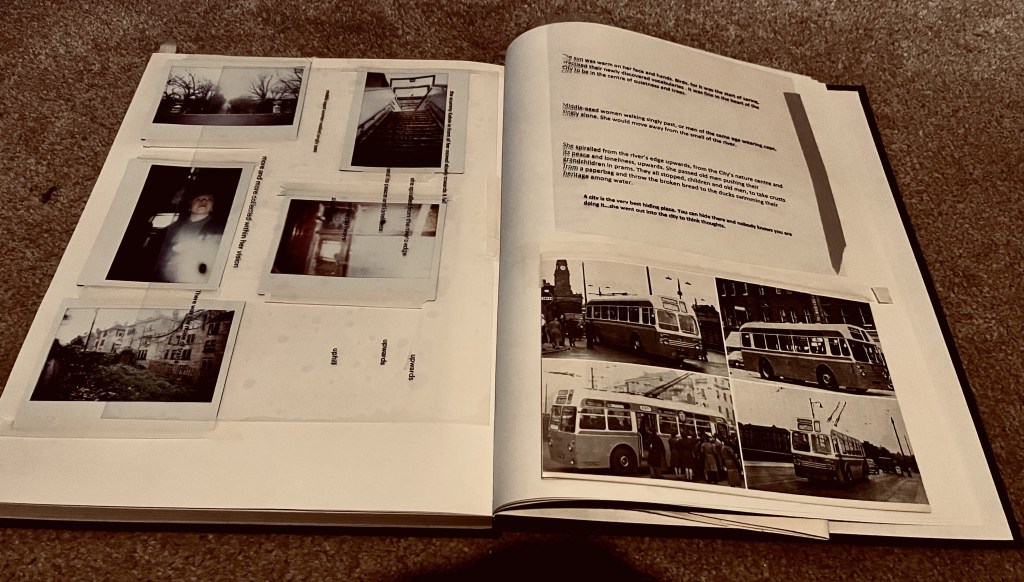
A project commissioned by Women Make Cities, an interdisciplinary research network based at University of Edinburgh and funded by the Royal Society of Edinburgh.
For ‘Make a space for me’: Dreams of a post-war feminist city’, I’ve wandered through archives – physical, digital, imaginary – in pursuit of the writer Joan Ure (1918 – 1978). Following routes well known to her, I’ve crossed the city by bus and travelled by train between Glasgow Queen Street and Edinburgh Waverley seeking to uncover Ure’s words buried in special collections and the papers of other writers. On my journeys, I imagine how Ure experienced Glasgow, feeling – as she felt – that the city is both a place to hide and a place to become more fully yourself, unravelling thoughts and memories as you walk its streets.
In her radical texts, Ure centres women in a hostile cityscape, upturning traditions of gender, national identity, and cultural hierarchies in the process. Ure envisions an alternative to patriarchal, post-war Glasgow a place that she felt was dominated by ‘the Scottish Soldier, the Scottish policeman, the Scottish Jack Tar’. Despite being haunted by the fear that people would only see her work as ‘unbalanced’ feminist polemic, Ure continued to write poetry and plays that made space for women in public life. Her writing reveals a unique, little heard perspective on mid-century Glasgow’s violent masculine culture and its effects on the reality of women’s daily lives. Ure’s female protagonists navigate an often-threatening city – sometimes loudly protesting their right to freedom, sometimes simply seeking private moments of joy.


Women’s place in both the city and the cultural landscape was an ongoing theme in Ure’s work but ‘New Journey Forth’, an undated short story, became a particular touchstone for my project. The story follows a woman recently discharged from a convalescent home as she heads out into the city for the first time since her illness. Stepping ‘out of the invalidity of sickness into the strength of the street’, she is initially disoriented – the city has changed, it’s crowded and hectic, she feels totally out of place. The shock of shifting from the languid time of illness to the chaotic frenzy of urban life is almost overwhelming. In her absence, the trams have been decommissioned and the roads are dominated by cars – ‘does everyone have cars then?’ she asks herself. She catches a bus, joining a lively group of women and a few retired men who look ‘out of their depth…a little ashamed to be traveling at such a time’. Gradually, the woman is buoyed by the confidence of people around her – another woman who runs through the traffic to jump on the back of the bus; the bus conductor, a West Indian man, calmly carrying out his duties despite being ‘thousands of miles from where he was born’; and an American tourist, likewise at ease in the city, despite its unfamiliarity. In the act of helping the tourist navigate his map, the woman takes ownership of her city once again. She joins the crowd, becomes part of the city madness. But in typical Ure style, the story ends on a note of ambiguity: ‘at a crossing where the lights had broken down a white coated policeman had taken over. Cars that would have been impatient at the lights and pedestrians who never could quite trust lights anyhow moved across in the shadow of his arm. Lifting her head high, her eyes sad, she knew that she would try to cross even with the simple, mechanical guidance of the lights, the lights that were man-made and might fail at any time’.
New Journey Forth story takes place sometime shortly after September 4th 1962, the date that Glasgow’s trams ceased their rattling, rickety processions through the city. The zesty flash of green and orange that brightened smog-blackened streets was no more. Public transport was out of fashion and, as in metropolises across the western world, post-war urban renewal, cars were hailed as the future. Glasgow city centre was succumbing to the architectural violence of the Bruce plan, which saw the tenement blocks and streets around Charing Cross ripped up and replaced with the M8 motorway. Residents were cleared to isolated high rises on the edges of the city. In New Journey Forth, the protagonist’s disorientation and her wariness of the man-made environment taps into a broader sense of unease at the top-down changes imposed on the city.



This is an ongoing project, but you can access two recent outputs (a pamphlet and an audio piece) below.

Make Space for Me Pamphlet – view here.
Audio mix of Joan Ure’s poetry & bus journeys through Glasgow – listen here